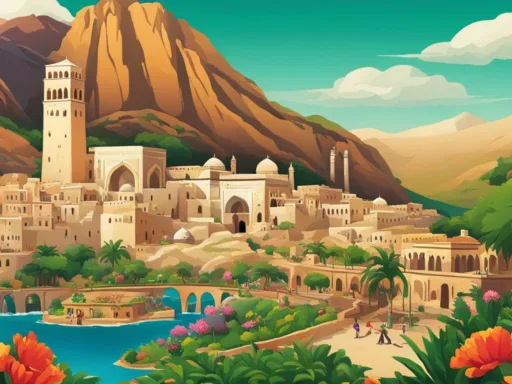Often overlooked by globetrotters, Lebanon is a country that defies expectation, offering a treasure trove of ancient history and Mediterranean allure, but when is the best time to visit Lebanon? Flanked by sand-swept landscapes on one side and the sparkling Mediterranean Sea on the other, it presents so much more beyond its affluent, cosmopolitan capital, Beirut. The real question beckons – when should one venture into this diverse land to fully embrace its beauty and cultural depth?
Lebanon’s travel seasons are as varied as its historical landmarks, each bringing a different piece of the mosaic to life. With our comprehensive Lebanon weather guide, you’ll discover why traveling during specific times of the year can offer a unique blend of comfort, beauty, and tranquility. From the majestic Roman ruins scattered throughout Baalbek, Byblos, and Tyre, to the exuberant ski slopes of Mzaar Kfardebian, timing your travel can vastly enhance your Lebanese journey. So, when to go to Lebanon for the utmost experience? Let’s take a dive into the seasonally shifting landscapes of this Mediterranean marvel.
Key Takeaways
- Spring and late fall offer the most temperate climate for exploring Beirut’s historical richness.
- Lebanon’s off-peak travel seasons ensure less crowding at major tourist sites.
- Discovering the Roman heritage in milder weather enhances the overall experience.
- Winter months in Lebanon are a call to adventure-seekers for skiing and snowboarding.
- Each Lebanese season promises its own unique set of activities and experiences.
- Understanding Lebanon’s climate can significantly affect travel plans and expectations.
Unveiling the Beauty of Lebanon’s Seasons
When contemplating the Best Time to Visit Lebanon, understanding the country’s Lebanon travel seasons is pivotal. Lebanon’s unique Mediterranean climate offers a refreshing departure from the stereotypically arid Middle Eastern weather, featuring 300 days of sunshine and well-defined seasons. As one dives into the Lebanon weather guide, it becomes clear that seasons here are not just a backdrop but a central character in the country’s narrative.
For many seasoned travelers and in-the-know visitors, the Off-peak times in Lebanon signify an opportune moment to immerse themselves in the local culture and landscape without the bustle of the high season. Embrace the gentle breezes of May and June or the crisp air in October and November to discover a period where mild temperatures and reduced crowds allow for a more intimate experience of Lebanon’s treasures.
Distinguished by the serene beauty of Kadisha Valley and the verdant expanses of Horsh Ehden, these months offer an idyllic setting for outdoor enthusiasts. As the Bekaa Valley unfolds in the bounty of its vineyards, wine connoisseurs find a paradise in the making, where the grapevines whisper stories of ancient civilizations and local craftsmanship.
| Season | Activities | Weather |
|---|---|---|
| Late Spring (May-June) | Trekking and Wine Tasting | Mild and pleasant |
| Autumn (October-November) | Archaeological explorations | Cool with occasional rains |
| Summer (July-August) | Beach leisure and Cultural festivals | Warm and sunny |
| Winter (December-March) | Skiing and Snowboarding | Cold with snow in the mountains |
As illustrated above, Lebanon’s seasonality offers something for every type of traveler, making it essential for one to consider the rhythm of local climate when planning a journey. To truly appreciate the totality of Lebanon’s grace, the balancing of weather, activity, and the presence of other tourists must play a role in shaping your itinerary, thereby ensuring an authentic and uninterrupted glimpse into the heart of this Mediterranean gem.
Spring into Lebanon’s Cultural Riches and Pleasant Climates
As the winter chill fades, Lebanon becomes a verdant paradise, welcoming travelers with its warm embrace. The season of renewal, spring is often cited as the peak season in Lebanon for good reason. It marks the return of lush landscapes and the perfect window to experience the rich cultural heartbeat of the nation. Wondering when to go to Lebanon? This is your answer.

Discover Beirut’s Historical Wonders in Ideal Weather
Beirut, the historic and effervescent capital, dons its most enigmatic hues during spring. Unhampered by the heat of the summer sun, visitors can delve into the city’s ancient past and cosmopolitan present. A Lebanon weather guide would highlight this period as the idyllic setting to stroll through the storied streets, where temperatures linger enticingly between the high teens and early twenties Celsius.
Adventures in Baalbek, Byblos, and Tyre with Less Crowding
Spring also offers a respite from the throngs of tourists that flock to Lebanon’s archaeological jewels in the summer. The iconic sites of Baalbek, with its colossal Roman temples, the coastal charm of Byblos, and the ancient maritime stronghold of Tyre, become serene havens for culture and history enthusiasts. It is a time for unhurried exploration, offering deeper connections with the past amid the serenity of the off-peak ambiance.
- Baalbek’s Roman Coliseum: Experience history without the hindrance of crowds
- Byblos’ Old Souk: Savor the tranquility in one of the world’s oldest continuously inhabited cities
- Tyre’s Hippodrome: Walk the grounds of one of the largest Roman hippodromes in the ancient world, in relative solitude
Whether it’s indulging in the rich tapestry of history or simply basking in the gentle Mediterranean sun, spring in Lebanon is a medley of comfort, culture, and unique travel opportunities making it a highlight within Lebanon travel seasons.
Best Time to Visit Lebanon: Summer Delights on Mediterranean Shores
Lebanon’s peak season blooms under the summer sun, extending a bouquet of activities and experiences, particularly for those enchanted by the Mediterranean’s golden coasts. With temperatures climbing, the country’s crystal-clear waters and vibrant beach life present the perfect tableau for sun-seekers.
Beach Bliss and Coastal Culture in Lebanon’s Prime
Imagine stepping onto the warm sands of beaches that stretch from the cosmopolitan allure of Beirut to the ancient port city of Byblos. Here, the Best Time to Visit Lebanon is from June through August, when days are long, nights are balmy, and the sea breeze carries the scent of adventure and relaxation.
In this season, Lebanon’s coastline is a canvas of cultural expression. Festivals, music, and culinary feasts animate the seaside, highlighting the rich tapestry that Lebanese culture weaves during these months. Travelers from across the globe converge on its shores, immersing themselves in an experience that goes beyond mere sunbathing.
Escape to the Mountains: Bcharre and Cedars’ Natural Splendor
For those seeking reprieve from the coastal fervor, the Lebanon Mountains beckon. Bcharre, the town known for its ancient Cedars, provides a serene counterpoint to the summer heat. Its cooler climes and majestic trails are an open invitation to explore the rugged beauty of this region.
| Lebanon Travel Seasons | Coastal Attractions | Mountain Retreats |
|---|---|---|
| June – September (Peak Summer) | Beirut’s Riviera, Byblos’ Ancient Harbor | Bcharre’s Hiking Trails, Cedars of God |
| Off-peak Season Alternatives | Quieter Beach Experiences | Solitude among Ancient Groves |
The off-peak times in Lebanon, especially the late summer, offer a different flavor of peace and tranquility. The throngs of tourists wane, yet the beauty of the Cedars and the undulating mountain vistas remain undiminished. By visiting during this time, you’re invited to a private audience with Lebanon’s natural splendor.
Whether you’re drawn to the lively beaches or the quiet majesty of the mountains, planning your visit around the Lebanon travel seasons can greatly enhance your experience. As the heart of the Middle East beats to the rhythm of summer, there’s undoubtedly a perfect Lebanese moment waiting for every traveler.
Fall in Love with Lebanon’s Harvest Festivities and Mild Temperatures
As the swelter of summer subsides, the nation reveals an entirely different charm, inviting visitors to experience the best time to visit Lebanon. Draped in the hues of harvest, the fall season heralds a serene interlude poised between the exuberance of summer and the quiescence of winter. This period, celebrated for its mild temperatures and lush landscapes, is a quintessential snapshot of Lebanon’s natural glory. It beckons those wondering when to go to Lebanon to choose these months for a journey marked by cultural immersion and natural splendor.
The Lebanon weather guide recognizes the precious equilibrium of climate that autumn bestows upon the land. Vineyards in the Bekaa Valley wear their bounty with pride, offering travelers the chance to partake in a timeless tradition during the grape harvest. It’s a festive moment that interlaces the fruit of the vine with cultural narratives dating back centuries. The aura of celebration is captivating, with local communities joyfully embracing age-old practices of harvest and the transformation of grapes into storied Lebanese wine.
The Bekaa Valley Grape Harvest – A Toast to Tradition
Experiencing the harvest in the Bekaa Valley is not just about witnessing the extraction of nature’s bountiful produce; it is participating in a ritual that celebrates Lebanese heritage. This period, away from the scurry of off-peak times in Lebanon, provides ample opportunities to explore beyond the vines. The majestic Cedars await, standing as sentinels to Lebanon’s history, while apple orchards and olive groves beckon with their seasonal promise. Unhurried exploration is the order of the day, embracing a pace of travel as gentle as the fall breeze winding through Lebanon’s awe-inspiring landscapes.






